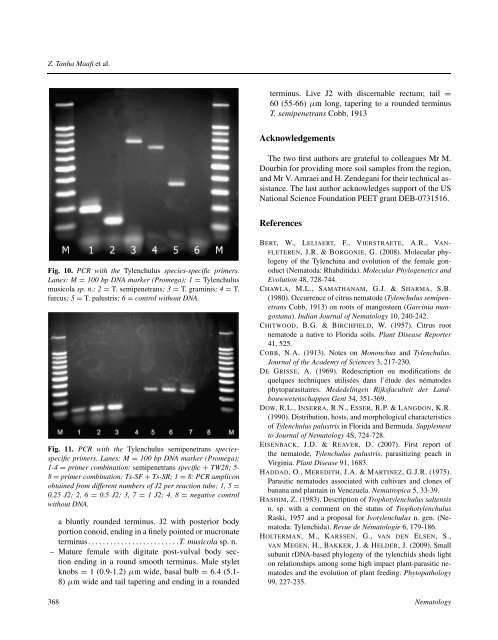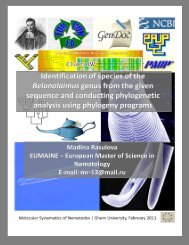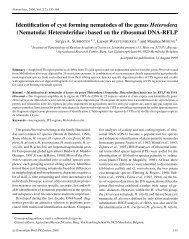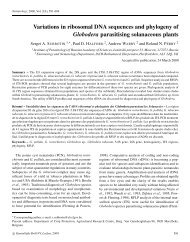Description of Tylenchulus musicola sp. n. (Nematoda ...
Description of Tylenchulus musicola sp. n. (Nematoda ...
Description of Tylenchulus musicola sp. n. (Nematoda ...
Create successful ePaper yourself
Turn your PDF publications into a flip-book with our unique Google optimized e-Paper software.
Z. Tanha Maafi et al.<br />
terminus. Live J2 with discernable rectum; tail =<br />
60 (55-66) μm long, tapering to a rounded terminus<br />
T. semipenetrans Cobb, 1913<br />
Acknowledgements<br />
The two first authors are grateful to colleagues Mr M.<br />
Dourbin for providing more soil samples from the region,<br />
and Mr V. Amraei and H. Zendegani for their technical assistance.<br />
The last author acknowledges support <strong>of</strong> the US<br />
National Science Foundation PEET grant DEB-0731516.<br />
References<br />
Fig. 10. PCR with the <strong>Tylenchulus</strong> <strong>sp</strong>ecies-<strong>sp</strong>ecific primers.<br />
Lanes: M = 100 bp DNA marker (Promega); 1 = <strong>Tylenchulus</strong><br />
<strong>musicola</strong> <strong>sp</strong>. n.; 2 = T. semipenetrans; 3= T. graminis; 4= T.<br />
furcus;5= T. palustris;6= control without DNA.<br />
Fig. 11. PCR with the <strong>Tylenchulus</strong> semipenetrans <strong>sp</strong>ecies<strong>sp</strong>ecific<br />
primers. Lanes: M = 100 bp DNA marker (Promega);<br />
1-4 = primer combination: semipenetrans <strong>sp</strong>ecific + TW28; 5-<br />
8 = primer combination: Ts-SF + Ts-SR; 1 = 8: PCR amplicon<br />
obtained from different numbers <strong>of</strong> J2 per reaction tube; 1, 5 =<br />
0.25 J2; 2, 6 = 0.5 J2; 3, 7 = 1 J2; 4, 8 = negative control<br />
without DNA.<br />
a bluntly rounded terminus. J2 with posterior body<br />
portion conoid, ending in a finely pointed or mucronate<br />
terminus.........................T. <strong>musicola</strong> <strong>sp</strong>. n.<br />
– Mature female with digitate post-vulval body section<br />
ending in a round smooth terminus. Male stylet<br />
knobs = 1 (0.9-1.2) μm wide, basal bulb = 6.4 (5.1-<br />
8) μm wide and tail tapering and ending in a rounded<br />
BERT, W., LELIAERT, F., VIERSTRAETE, A.R., VAN-<br />
FLETEREN, J.R.&BORGONIE, G. (2008). Molecular phylogeny<br />
<strong>of</strong> the Tylenchina and evolution <strong>of</strong> the female gonoduct<br />
(<strong>Nematoda</strong>: Rhabditida). Molecular Phylogenetics and<br />
Evolution 48, 728-744.<br />
CHAWLA, M.L., SAMATHANAM, G.J. & SHARMA, S.B.<br />
(1980). Occurrence <strong>of</strong> citrus nematode (<strong>Tylenchulus</strong> semipenetrans<br />
Cobb, 1913) on roots <strong>of</strong> mangosteen (Garcinia mangostana).<br />
Indian Journal <strong>of</strong> Nematology 10, 240-242.<br />
CHITWOOD, B.G. & BIRCHFIELD, W. (1957). Citrus root<br />
nematode a native to Florida soils. Plant Disease Reporter<br />
41, 525.<br />
COBB, N.A. (1913). Notes on Mononchus and <strong>Tylenchulus</strong>.<br />
Journal <strong>of</strong> the Academy <strong>of</strong> Sciences 3, 217-230.<br />
DE GRISSE, A. (1969). Redescription ou modifications de<br />
quelques techniques utilisées dans l’étude des nématodes<br />
phytoparasitaires. Mededelingen Rijksfaculteit der Landbouwwetenschappen<br />
Gent 34, 351-369.<br />
DOW, R.L.,INSERRA, R.N.,ESSER, R.P.&LANGDON, K.R.<br />
(1990). Distribution, hosts, and morphological characteristics<br />
<strong>of</strong> <strong>Tylenchulus</strong> palustris in Florida and Bermuda. Supplement<br />
to Journal <strong>of</strong> Nematology 4S, 724-728.<br />
EISENBACK, J.D. & REAVER, D. (2007). First report <strong>of</strong><br />
the nematode, <strong>Tylenchulus</strong> palustris, parasitizing peach in<br />
Virginia. Plant Disease 91, 1683.<br />
HADDAD, O.,MEREDITH, J.A.&MARTINEZ, G.J.R. (1975).<br />
Parasitic nematodes associated with cultivars and clones <strong>of</strong><br />
banana and plantain in Venezuela. Nematropica 5, 33-39.<br />
HASHIM, Z. (1983). <strong>Description</strong> <strong>of</strong> Trophotylenchulus saltensis<br />
n. <strong>sp</strong>. with a comment on the status <strong>of</strong> Trophotylenchulus<br />
Raski, 1957 and a proposal for Ivotylenchulus n. gen. (<strong>Nematoda</strong>:<br />
Tylenchida). RevuedeNématologie6, 179-186.<br />
HOLTERMAN, M., KARSSEN, G., VAN DEN ELSEN, S.,<br />
VAN MEGEN, H.,BAKKER, J.&HELDER, J. (2009). Small<br />
subunit rDNA-based phylogeny <strong>of</strong> the tylenchids sheds light<br />
on relationships among some high impact plant-parasitic nematodes<br />
and the evolution <strong>of</strong> plant feeding. Phytopathology<br />
99, 227-235.<br />
368 Nematology
















